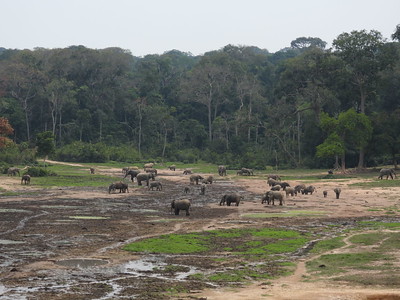Sangha Trinational

Sangha Trinational is a large and intact natural landscape, mainly consisting of humid forests plus wetlands and natural clearings.
These three contiguous national parks are centered along the Sangha River, a tributary to the Congo River. They harbour tree and mammal species that are much threatened elsewhere due to exploitation and poaching. Large mammals such as Forest Elephants, Gorillas, Chimpanzees, Sitatunga and Bongo are still present in healthy numbers.
Community Perspective: Els visited Dzanga-Ndoki National Park in the Central African Republic, as did Randi, arriving from Congo by the Sangha River. The other two parks, Lobéké National Park in Cameroon and Nouabalé-Ndoki National Park in Congo, have stayed unreviewed so far.



Map of Sangha Trinational
Community Reviews
Els Slots

These natural clearings filled with wildlife from the Congo Basin are the holy grail among mammal watchers. For me, Dzanga Ndoki (the Central African Republic part of this transnational site) was to be a splurge visit in March 2020 – but it became my Covid travel disaster. After the park reopened, I still wanted to go but the prices rose beyond belief. Fortunately, I found a group tour operator wanting to do it for much less by entering overland from Cameroon.
This site also had been unreviewed so far on this website. Sangha Trinational WHS consists of 3 parks, of which the one in the Central African Republic (C.A.R.) surprisingly is the best equipped to receive visitors. Lobéké in Cameroon is rundown, while Nouabalé-Ndoki in Congo is temporarily closed and rumours have it that they want to turn it into a luxury destination. I wrote a Getting There topic on the Forum to elaborate on the practicalities of visiting the park in the C.A.R. This review further deals with what you can expect there.
Our first day was spent at Dzanga Bai, the most famous forest clearing, known as ‘the Serengeti of the Forest’. It’s already a fine place to get to, starting with a drive through the forest of about 45 minutes and then an easy hike of the same duration. The latter includes a foot crossing of some flooded areas, where the water reaches just below the knee. Especially on the way back the cool water provided a welcome respite from the heat.
After walking through the forest for a while, you suddenly begin to see the sky again: that’s where the Dzanga Bai starts. A comfortable viewing platform (shaded, with chairs, and we brought drinks and lunch) provides the classic overview of this forest clearing. The Bai is the size of several football fields. There were already some 80 forest elephants present when we arrived and also a small group of forest buffalo. Other forest animals come here too, but they are shy and seem to get bullied by the elephants. They also chased the buffaloes away after a while.
What follows is hours of silent observation of the coming and going of the elephants. They take mud baths, socialize and some rowdy young guys have a few trunk fights. In this season (January) there were also many babies and large bulls present. We lasted 4 hours and it was almost a meditative experience.
During the second day in the park, we drove even further inside on a dirt road surrounded by very high trees. It ends at Bai Hokou, another ‘bai’ that is visited by forest animals but not in the same numbers as Dzanga Bai. Here lies the ranger and research station for the park’s western lowland gorillas. Until last year they had 3 habituated gorilla groups here, but within a month two of the silverbacks died (of natural causes). So we went to visit the remaining family of Makumba, a 40-year-old male with two wives and four kids. Before the visit, we had to do a rapid Covid test at the park office to prevent we would transmit the disease to the animals.
After having done mountain gorilla treks in Bwindi and Virunga before, I was curious to see how the lowland gorillas would differ. The flat terrain surely makes the hike easier, but it’s a humid area and you only walk on animal trails so there are a lot of roots and branches along the way. I was in the second ‘batch’ of visitors of my tour group (any group larger than four would have a hard time getting a view), so the trackers already found the gorillas and we reached them after two hours of hiking. They continued to walk away from us at first and were constantly turning their backs to us - we had to follow them crawling through the bushes. Based on this experience I’d say the mountain gorillas are harder to reach but easier to see once you have arrived. The allowed one hour at the gorillas of Bai Hokou was hard work, but finally, two of them settled down to eat and we could get good pictures from about 3m away. Their looks are slightly different from the mountain gorilla, with a streak of red-brownish hair on their forehead and altogether a different facial build. As they live in smaller family groups, you also see fewer individuals during your visit.
Sangha truly stands out because of:
- How ‘wild’ it is - it's almost untouched by human interference, where national parks in Southern Africa and Eastern Africa often are 'engineered' nowadays, with species being reintroduced, their numbers regulated, fences built, waterholes dug out, hardly a lion to be seen without a collar. Especially Dzanga Bai is just what it has always been, with only a viewing platform for scientists and tourists to observe. We also saw a wild, unhabituated gorilla cross the road on the way to Bai Hokou.
- The opportunity to see the forest mammal species of the Congo Basin. They all (elephants, buffaloes, gorillas) are a bit smaller in size than similar species elsewhere. They are well adapted to living in the dense forest and the narrow spaces that come with it. Even the humans are smaller here! The areas around the park are inhabited by the Ba’ka people, and they also are employed as gorilla trackers. Just following them through the bush you come to admire their agility and with their small stature they avoid getting all the branches in their faces as clumsier and taller tourists get.
It sure was worth the 4-year wait and the 3 full days of travel to get to Dzanga Ndoki. The visit made my appetite for other WHS in the Congo Basin like Odzala and Ivindo grow even stronger.
Read more from Els Slots here.
Randi Thomsen

After a long day on the Sangha River from Oesso, we arrived at Dzanga-Sangha National Park we arrived at eight o’clock, the last leg in darkness. The speedboat journey through untouched nature, passing isolated villages and local fishermen, was serene and surreal - we encountered only one motorized boat the entire day.
Our stay was at Doli Lodge, managed by WWF and beautifully situated on the Sangha River. The lodge exceeded expectations and offered more comfort than its counterpart in Odzala-Congo. Though the original plan was for four nights, it was shortened to three due to the temporary suspension of gorilla trekking. The unfortunate loss of the last silverback means the groups need time to stabilize. However, the park has much more to offer.
Day 1:The day began with a visit to Dzanga Bai, the most famous mineral-rich clearing in the area. A 45 minutes drive, then a 40-minute easy walk, including a river crossing, brought us to this magical spot. As we arrived, around 120 forest elephants of different sizes and colors were gathered on the plain. What a sight!. It was mesmerizing to sit in the observation tower and watch their coming and going. They even have their own spa treatment covering themselves in golden mud. Researchers counted up to 144 elephants at its peak, an unparalleled wildlife experience. Late in the afternoon, a family of forest hogs made an appearance. At four o’clock, we returned to the lodge for a cold beer and a sunset over the Sangha River. Truly, a day to remember!
Day 2: Our second day was spent with the Ba’Aka community, often referred to as pygmies. Although smaller in height, their vibrant personalities and rich culture left a lasting impression. The day began with a visit to a local village, where a lively selection process determined which of the villagers would join us. They all jumped on the back of the jeep and we ventured into the rainforest accompanied by songs and laughter. The hunt for red duikers involved setting nets, making noise, and hoping for success? They were so efficient to put up and take down the net. Along the way, we learned about the forest: plants for water, building shelters, and medicinal trees. Their genuine joy and connection to the jungle were infectious, making the experience authentic and unforgettable.
In the afternoon , we returned to the village for a cultural performance, starting with an incredible display of water drumming on the river - a mesmerizing rhythm created from splashing water. The village dance later on felt less natural compared to the forest but still provided a fascinating glimpse into Ba’Aka life. The day was both an adventure and a privilege, offering insight into their challenging yet resourceful way of life. According to several media the life expectancy is very low, only 35 years, so they live a though life.
Three nights/two days felt too short. The rainforest of the Congo Basin is magical - remote, untouched, and teeming with life. Though gorilla trekking was unavailable, the experience of Dzanga Bai and the Ba’Aka people made this trip truly unique. In addition, this must be one of the most remote places we have been and definitely worth the effort to get there.
Practical Information
This journey was organized by our friends in Old Explorer (www.oldexplorer.com), experts in planning African adventures. We were fortunate to join a pilot tour combining Odzala-Kokoua National Park and Dzanga-Sangha, starting from Brazzaville.
Access: Reaching Doli Lodge required a full day by boat from Oesso (Congo). The lodge facilitated the boat ride and the necessary visa for the Central African Republic. Els mentioned other ways of reaching the park
Note: Gorilla trekking is currently suspended, with an estimated resumption in about a year
Community Rating
Site Info
- Full Name
- Sangha Trinational
- Unesco ID
- 1380
- Country
- Cameroon Central African Republic Congo (Republic)
- Inscribed
- 2012
- Type
- Natural
- Criteria
-
9 10
- Categories
- Natural landscape - Forest
- Link
- By ID
Site History
2012 Inscribed
2011 Referred
2011 Advisory Body overruled
IUCN had advised Deferral
Site Links
Unesco Website
Official Website
Related
In the News
Connections
The site has 27 connections
Damaged
Ecology
Geography
Human Activity
Trivia
Visiting conditions
WHS Names
WHS on Other Lists
World Heritage Process
Visitors
9 Community Members have visited.
The Plaque
 (photo by Els)
(photo by Els)